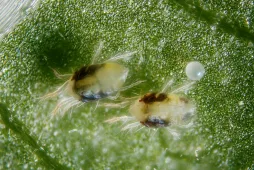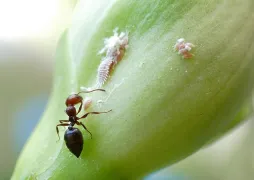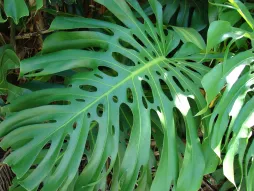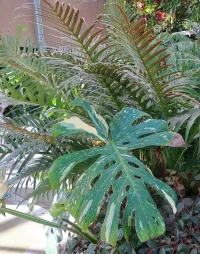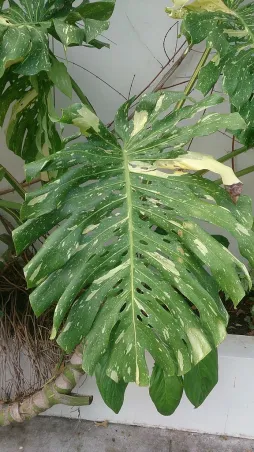Rhaphidophora tetrasperma, the mini Monstera
Appearances can be deceptive! The mini Monstera (in Latin Rhaphidophora tetrasperma) is only a distant relative of the Monstera deliciosa variegata. Although both plants are members of the Araceae family, they do not belong to the same genus. What's more, Rhaphidophora tetrasperma does not grow in the mountains of South America. It can be found several thousand kilometers away, in the forests of Malaysia.
How to recognize the mini Monstera, Rhaphidophora tetrasperma?
Rhaphidophora tetrasperma is a climbing perennial. Its stems can extend over five meters in the wild. In pots and in our latitudes, they rarely exceed two meters.
The slender green stems bear aerial roots. They help the plant to hold on and climb. They also serve to absorb moisture.
The oval or lanceolate leaves measure up to 40 centimetres in all directions. Dark green, they are slightly fleshy. Some blades have fenestrations, usually in the center, close to the main vein. The cut foliage allows the plant to circulate light to the leaves growing at its base.
Flowering is rare indoors. But some specimens can produce flowers. These consist of a creamy spathe enveloping a spike of white flowers.
The plant contains calcium oxalate crystals. These are toxic to humans and animals if ingested or if they come into contact with the skin. Keep your mini Monstera out of reach of your dog, cat or baby. Wear gloves when trimming.
Our maintenance tips
Rhaphidophora tetrasperma are not difficult to care for. Regular watering, a little moisture, a pot optimized for drainage and a little fertilizer are all that's needed.
Watering
Rhaphidophora tetrasperma likes humidity, but not at root level. Water only when the rootball has dried to a depth of two or three centimeters.
Use non-calcareous water, such as rainwater, at room temperature. If you've placed your houseplant on a dish, empty the stagnant water each time it appears.
Spray
The air in our apartments is too dry for plants used to high humidity. Mist your Rhaphidophora tetrasperma with water at room temperature.
Rainwater is preferable to tap water. Tap water causes white spots on the foliage.
Repotting
In spring, transfer your Rhaphidophora tetrasperma to a larger pot, so that it can continue to grow.
Re-pot your Rhaphidophora tetrasperma to give it more space. Choose a pierced terracotta or plastic pot that will allow it to continue growing.
At the bottom, place a draining potting soil and then transplant your plant. Pack the rootball to prevent it from becoming too airy.
Rhaphidophora tetrasperma like to climb. You can support their development by providing them with a stake to hang on.
Fertilization
You can stimulate the development of your plant during its growth phase, in spring and summer, with fertilizer.
Addgreen plant fertilizer to watering water.
Cleaning
Remove dust from foliage with a clean, damp cloth. This will enable your plant to take full advantage of the sunlight.
Pinch
Pinch your Rhaphidophora tetrasperma during its growing season.
Rhaphidophora tetrasperma don't cut themselves. But you can pinch the ends of the stems to densify the plant and create new branches.
Your Mini Monstera is toxic. Wear gloves during the operation to avoid skin rashes.
Cutting
Cutting is carried out during the strong growth phase, generally in spring and early summer.
Select a healthy stem. Take a portion of about ten centimetres with at least one leaf and one aerial root.
Always use a clean instrument to prevent the spread of disease, and a sharp one to facilitate healing.
Once you've obtained your graft, place it in a vase or glass filled withwater at room temperature. Make sure the node is completely submerged.
Place your cutting in a bright spot, but without direct sunlight. Change the water regularly to keep it clear.
Place your cutting in a bright spot, but without direct sunlight. Change the water regularly to keep it clear.
Diseases / Threats
Information
| Family | Araceae - Araceae |
| Type | Rhaphidophora - Rhaphidophora |
| Species | Rhaphidophora tetrasperma - Rhaphidophora tetrasperma |
| Lifecycle | Perennial |
| Foliage | Evergreen |
| Exposures | |
| Substrats | |
| Planting method |
In pots |
| Categories | |
| Origin |
South Asia |
| Hardiness (USDA) | 10b |
| Leaf color |
|
| Flower colors |
|
| Fruit colors |
|
Discover plants from the same family














